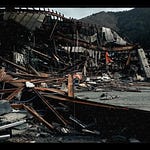
On September 11, 2001, the world witnessed the most significant terrorist attack. For those working that day, it started normal, but by the end of the day, our world changed, and the way we did our job did as well. I was assigned to the Jefferson station in Los Angeles on the border of Colver City, down the street from the radio station KABC right off the I-10 freeway. This area is a bustling part of the city. My shift started at 0700 PT, and I hit the road at about 0530 PT to make it on time. As part of my morning routine, I turned on the radio to AM 790 KABC to get the news and traffic report. L.A. Traffic is a bear at all times of the day. I recall this day as if it was yesterday; I turned on the on-ramp to the freeway, and the news reported that a plane had struck the World Trade Center. My first thought was a small plane had hit the tower. Small Aircraft hitting buildings in NYC happened before. Then the second plane hit. I knew this was an act of war.
On that Tuesday morning, 19 al-Qaeda terrorists hijacked four American commercial flights destined for the West Coast and intentionally crashed them. Two planes—American Airlines Flight 11 and United Airlines Flight 175—departed from Boston, and Flight 11 struck New York City’s World Trade Center North Tower at 8:46 am E.T. and Flight 175 the South Tower at 9:03 am E.T. resulting in the collapse of both towers. A third plane, American Airlines Flight 77, leaving Dulles International Airport in Virginia, crashed into the Pentagon at 9:37 am E.T. The final plane, United Airlines Flight 93, departing from Newark, N.J., crashed in a field in Shanksville, Pa., at 10:03 am E.T. after passengers stormed the cockpit and tried to subdue the hijackers.

In the space of less than 90 minutes on a late summer morning, the world changed. Nearly 3,000 people were killed that day. The events of 9/11 reshaped the global response to terrorism and reformed the field of emergency management. Disaster response was no longer a single jurisdiction issue; regional thinking, planning, and concern for regional impacts are now ingrained in local government organizations.
The City of Los Angeles became quiet, the I-10 freeway was empty, and the sky was void of Aircraft. We were on tactical alert, waiting for the attack on the west coast that never came. In the days and weeks after the attack, we started high-level talks between agencies on handling an event like 9/11.
Soon after, the money started to come in via grants. The Urban Area Security Initiative was established; some areas spent the money well, and others did not (that is a different story). In 2005 I took a job in Orange County, and what a difference in how the regional approach was taken.
The reasons for creating regional structures vary considerably from place to place. Emergency management recognizes that disasters do not respect geopolitical borders, thus, require a regional response. In addition, some states realized that if every emergency management office received a proportional share, federal EMPG and UASI funds would be too thinly distributed to be effective. Some states and local areas developed regional approaches for various reasons before 9/11 and have a clear plan to build functional capabilities at the regional level, or at least standardize or coordinate existing response structures, to improve local emergency management’s ability to respond to an emergency and provide population-based services.
The Orange County approach to regional coordination ought to be a case study on how to do it right. Now they are not perfect. However, they are better than most. The regional approach to emergency response and management is the most effective use of taxpayer dollars and resources.
Over three million people live in Orange County. In addition, it is home to two national sports franchises, Disneyland, several multinational corporate headquarters, and some of the most expensive real estate in the world. This makes Orange County an inviting target for domestic and international terrorism, not only in terms of physical damage but its economic, psychological, symbolic, and political impacts. For these reasons, the O.C. has to take a regional approach to emergency response and management.
Today On 9/11, we need to take the time and reflect and remember the people killed that day and those who have died in service-related injuries. It is up to us to take the lessons of 9/11 and use them to make our programs better in their honor.
Sponsors













Share this post